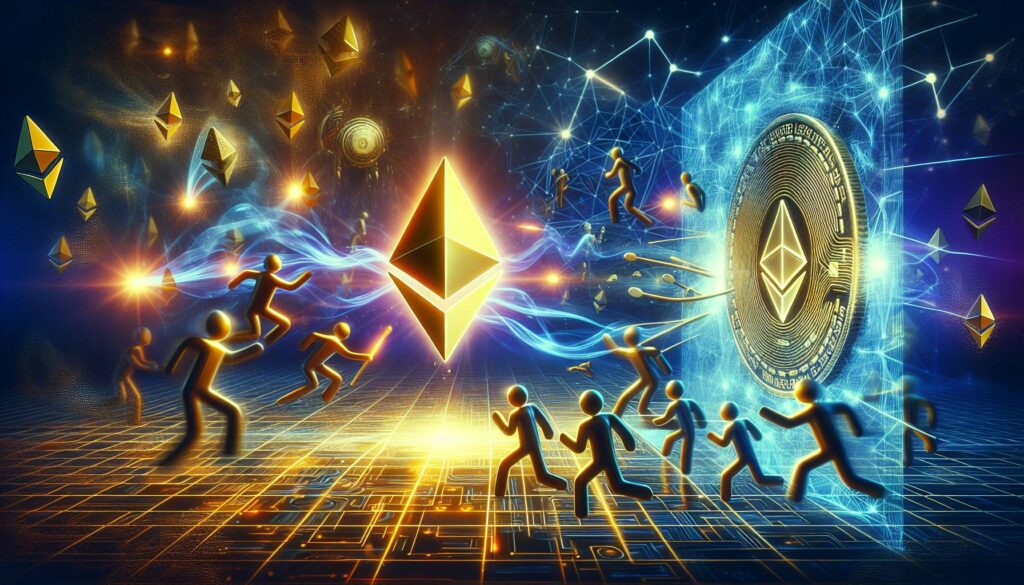The cryptocurrency world is buzzing with excitement following the recent activation of Pectra, Ethereum’s most significant upgrade in over a year. This transformative change, the largest since the highly discussed Merge in 2022, was rolled out last week and aims to enhance the overall functionality of the Ethereum network. Key improvements include streamlining staking for institutional investors, making wallets more accessible, and boosting transaction efficiency. However, the focus is already shifting toward the next major update, known as Fusaka.
Fusaka is set to further elevate the Ethereum experience, with developers committing to a crucial Ethereum Improvement Proposal (EIP) titled “PeerDAS.” This proposal seeks to address one of the longstanding challenges facing Ethereum: the efficient handling of large blocks of transaction data, commonly referred to as “blobs.” Introduced during the Dencun upgrade, blobs are designed to alleviate network congestion and reduce gas fees by allowing large data segments to be stored off the main chain.
“PeerDAS is super important since we want to help layer-2s scale,” said Parithosh Jayanti, a devops engineer at the Ethereum Foundation. “PeerDAS allows us to bump the blob limit significantly.”
The concept behind PeerDAS, which stands for Peer Data Availability Sampling, is to provide validators with the capability to download only partial data from these blobs. This innovation is expected to lower transaction costs significantly on layer-2 solutions like Arbitrum, Optimism, and Coinbase’s Base, enhancing the overall efficiency for users.
While Fusaka is scheduled to launch at the end of 2025, Ethereum’s developers have faced scrutiny regarding the pace of their upgrades. Pectra itself experienced multiple delays before its deployment, underscoring challenges within the team as competition in the blockchain space heats up. As Ethereum’s token price struggles amidst these changes, community discussions have turned critical, pondering whether the non-profit Ethereum Foundation’s leadership is affecting the network’s advancement.

Ethereum’s Major Upgrades: Pectra and Fusaka
Following the recent deployment of Pectra, Ethereum’s significant upgrade, developers are now planning the next upgrade, Fusaka. Here are the key points about these developments:
- Pectra Deployment:
- Significant code change since the Merge in 2022.
- Aims to make staking easier for institutions and improve wallet accessibility.
- Boosts transaction efficiency to enhance overall user experience.
- Upcoming Upgrade – Fusaka:
- Scheduled to go live at the end of 2025.
- Includes the Ethereum Improvement Proposal (EIP) “PeerDAS”.
- Will feature additional upgrades beyond PeerDAS.
- PeerDAS Details:
- Enables validators to download partial data from blobs for validation.
- Aims to support larger transaction data for better scalability.
- Intended to reduce transaction costs for layer-2 ecosystems like Arbitrum and Optimism.
- Significance of Blobs:
- Dedicated spaces for large transaction-related data stored off-chain.
- Helps reduce blockchain congestion and lower gas fees.
- Vital for enhancing the efficiency and cost-effectiveness of layer-2 networks.
- Developer Challenges:
- Past delays in upgrades, including Pectra’s postponements and testing issues.
- Ongoing criticism of developers for the pace of protocol changes amid competition.
- The community’s concerns regarding the Ethereum Foundation’s leadership and decision-making.
“PeerDAS is super important since we want to help layer-2s scale,” said Parithosh Jayanti, highlighting the upgrade’s potential impact on scalability.
These upgrades may significantly impact the Ethereum ecosystem, making transactions faster and cheaper, which can benefit both individual users and institutions operating on the blockchain. The ongoing discussion about upgrade delays and competitive pressures could also influence the future trajectory of Ethereum’s market position and attractiveness to developers and investors alike.
Ethereum’s Pectra Sets the Stage for Fusaka: A Comparative Analysis
The recent deployment of the Pectra upgrade represents a significant turning point for Ethereum, marking the most substantial code changes since the Merge in 2022. With various improvements aimed at staking accessibility for institutions and enhancing transaction efficiency, Ethereum is now setting its sights on the future with the upcoming Fusaka upgrade. But how does this positioning compare to similar developments across the blockchain landscape?
One of the highlights of the Pectra upgrade is its introduction of larger data “blobs,” which is crucial for supporting the burgeoning layer-2 cryptographic space. This approach stands out when compared to competitors like Solana and Binance Smart Chain, which have been aggressively promoting their transaction speed and lower costs. Solana, for instance, emphasizes its capability to handle a vast number of transactions per second, creating an enticing environment for developers. In contrast, while Ethereum’s upgrades like PeerDAS are poised to lower transaction costs and streamline processing, the competition’s hyper-focus on speed may appeal to users wishing to escape Ethereum’s notorious gas fee issues.
On the downside for Ethereum, the community’s growing frustration with the pace of its developers raises concerns. While the introduction of improvements post-Pectra illustrates adaptability, Ethereum’s delays—such as postponing the Pectra upgrade from late 2024 to May 2025—can potentially alienate users who are looking for rapid advancements in a dynamic market. Competitors that move quickly may lure those disenchanted with the Ethereum ecosystem, especially institutions evaluating options for validator operations. If Ethereum fails to keep up, it risks losing credibility among institutional investors and users looking for emerging opportunities.
The anticipated Fusaka upgrade—highlighted by its PeerDAS initiative—aims to bolster layer-2 transaction capabilities, which should benefit institutions and developers aiming for more efficient validation processes. This is particularly advantageous for those operating on solutions like Arbitrum and Optimism. However, Ethereum’s focus on technical refinement must also address the balance of user experience and transaction speed, which can play a pivotal role in attracting developers back to its platform.
Ultimately, while Pectra and Fusaka present promising advancements for Ethereum, the competitive landscape remains fierce. Institutions and developers evaluating scalability options may find themselves at a crossroads—contemplating whether the potential improvements in Ethereum’s infrastructure will outweigh the advantages offered by quicker, more agile competitors. As Ethereum navigates its path forward, the delicate balance between innovation and timely execution will be its litmus test for retaining relevance in a rapidly evolving blockchain ecosystem.

















